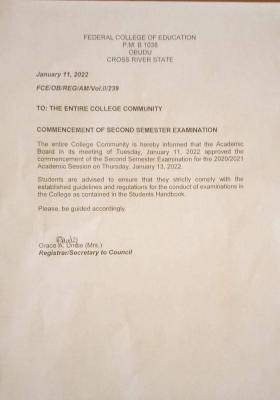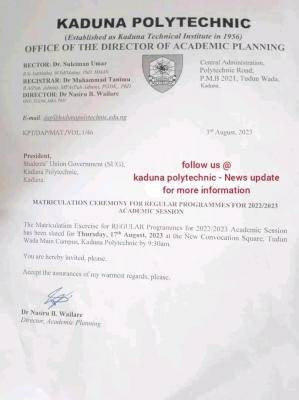
This week, I draw the curtain on this series. The questions from the two preceding articles have been interesting. A quick admonition though – a well prepared curriculum vitae is not the only thing you need to clinch a choice job.
It is nevertheless certainly a major variable in the box. No matter how properly packaged an accountant’s curriculum vitae is, he or she would surely, under normal circumstances, not be employed for an opening for an environmental engineer; and vice–versa!
Education, cognate experience, in some instances, place of residence and age of the applicant may also count. What a properly mailed curriculum vitae would do for the applicant is to scream courteously at the human resource personnel – “Hey, look at me, I am right here!”
Expertise in new media tools can also put an applicant on a decent footing. What do you know about the organisations you are applying to, beyond just elementary research? Have you checked out their Facebook timeline or Twitter feed if they have one? Have you read their blog posts to see their values in action, activities and interests?
Do you know who their competitors are? Can you spot the decision makers on their websites and go ahead to dig them out using Google? Act like a student in the Arts who knows that her lecturer is an aficionado of Augusto Boal and Paulo Friere and so goes ahead to feed Mr. Lecturer with their theories and perspectives during examination. Chances are that she will excel.
In a world now enormously connected by social networks, there is a new future to the art of job search. Before now, the norm was to finish from school, move around companies and manually drop hard copies of curriculum vitae. That has changed; any company doing that today stands the risk of having environmental activists kick against such environmentally unfriendly policy.
It seems easier now with the convenience that comes from tapping the computer or other mobile gadgets to send job applications. Already, recruitment firms are changing the approach to the game – an online form is all they ask applicants to fill and they only filter the information they need from there.
Since our identities are no longer just what we are offline, the future of job search is that our online identity will be a major influence for employment. While we await that future (one that is already here), job seekers can make the most of what the Internet offers today with the about 400 social networking sites. The curriculum vitae of average job seekers are usually limited to between two and three pages. What the new media can do is to stretch it to several pages and even include audio visuals.
Education, work, passion, hobbies and even aspirations of the job seeker can be captured and made available for a prospective employer through social media. In the future, it would be goodbye to sending email attachments when job hunting. CVs would be of the visual type. The prospective employer in the nearest future job search market wants a means with which to fully evaluate a candidate and know if they are fit for a job or not especially since even CVs can be deceptive. A good CV is not synonymous to a good applicant. The visual/social CV has the capacity to tell more than the regular CV would do.
The forecast is that employers in the nearest future would simply be asking for applicants’ link to their LinkedIn account (a business and professional networking site that debuted in 2003), blog(s), YouTube account etc.
All of these would allow employers to have a good understanding of the candidate’s natural make-up. Employers are already using activities on Facebook and Twitter to judge during applications processes. So you know, your Twitter bio is a CV on its own.
Your updates and comments on Facebook are good ways to gauge your thoughts. And of course the kind of pictures one shares on social networks also help at detecting whether one is the party or wobbly type. Not that it is wrong; it might not just suit the preferred profile of a particular opening while it would for some other ones. The recommendation is – cut your social media image according to what you do or desire offline. It helps. It also pays to speak up online because employers of the future would Google you. If there’s something you don’t want to be found, pull it down before it causes harm. Blogging about the industry you hope to work in can do the magic for you.
It allows anyone to know the profundity of your thought. You have more opportunity to show what you know about various issues and if you are resourceful, it would also reflect on your writing. Employers also want to crosscheck your claims; any applicant should not be too difficult to find online.
You do not want to be Pholoukeh Whocha on Facebook when your name really is Foluke Uche. Where possibly, write on national and international issues that concern the industry you want and mail to newspaper houses or online news sites since most have online presence. If the article is decent enough for publishing, it is another plus for your job search effort. Chances are that a prospective employer would find it when carrying out a background check on you. And you can always reference it as well.
Premised on questions and other concerns following part one and part two of this article, I am working with a career mentoring oufit – jarushub.com and would be willing to share standard CV formats, cover letters and other tips not covered here with willing individuals. Send a request to sola@onelifeinitiative.org to get a free copy of the e-book.
January, 2013, the World Bank was recruiting. The World Bank’s Africa team was looking for “two social media interns who are creative, smart, and committed to excellence.” It stated the qualifications it wanted but it did not ask for any CV. Instead, the instruction was – “Follow @WorldBankAfrica or @BM_Afrique and tweet your response to this phrase: #iwant2work4africa because…. Based on your response and if you make it to round 2, you will be sent a Direct Message with additional instructions.” That’s the kind of future this piece hints at and it is already here! Tweet @SolaFagro on Twitter to continue this conversation.




